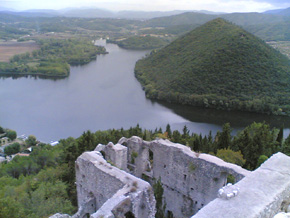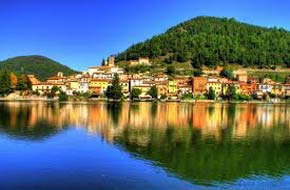


Piediluco is a picturesque medieval village whose name means "at the foot of the sacred grove". It grew in the narrow strip of land that runs between the lake and the mountain. The lake, which takes its name from the village, has the shape and appearance of an alpine lake, surrounded by hills, among which the Caperno mount - also called "the mountain of the Eco” - stands out for its characteristic cone shape.
The Piediluco lake is located in the southern part of the Umbria region, with a branch that stretches into the Lazio region. It is a true scenic gem, nestled as it is between the heights of the Valnerina. It reminds the Lake Como for the articulated form (with various "arms" that lie between the valleys).
This lake can be considered the largest natural lake basin in the region after the Trasimeno lake. It represents, along with other smaller lakes located in the province of Rieti, what remains of the great Lacus Velinus, a large alluvial lake formed after the Mesozoic era.
Irregular in shape with a perimeter of about 13 kilometers, the lake is at an altitude of 375 meters, with a maximum depth of about 19 meters attested. Its natural tributary is the Rio Fuscello, the other two tributaries are represented by man-made channels, one that connects it to the river Velino, the other that conveys a portion of the water taken from the Nera river,which is 42 km long. The bayou that is the Velino river is diverted to Marmore where it flows into the Nera river forming the Marmore waterfall.
The scenery of the lake is magnificent. Piediluco is the ideal place for those seeking a restoring vacation in an oasis of relax, but without sacrificing the discovery of the most important cultural and historic sites of Lazio and Umbria.
Its position, in fact, is very strategic: within a few tens of kilometers (meaning about a half hour drive) you can reach places such as Spoleto, Foligno, Montefalco, Assisi, Todi, Norcia, Cascia, Narni, Sangemini, the archaeological site of Carsulae (to stay in Umbria) as well as the picturesque medieval village of Labro (only 10 miles away, but in the province of Rieti), where you can enjoy the view of the entire lake Piediluco, the nearly 2,000 foot Terminillo mountain, the city of Rieti, the Cotilia baths and the Franciscan sanctuary of Greccio.
With less than an hour, you can reach Perugia and Viterbo (with the famous Terme dei Papi) and in just over an hour, Rome.
information taken from Wikipedia and Oasidipiediluco.it
The Piediluco lake is located in the southern part of the Umbria region, with a branch that stretches into the Lazio region. It is a true scenic gem, nestled as it is between the heights of the Valnerina. It reminds the Lake Como for the articulated form (with various "arms" that lie between the valleys).
This lake can be considered the largest natural lake basin in the region after the Trasimeno lake. It represents, along with other smaller lakes located in the province of Rieti, what remains of the great Lacus Velinus, a large alluvial lake formed after the Mesozoic era.
Irregular in shape with a perimeter of about 13 kilometers, the lake is at an altitude of 375 meters, with a maximum depth of about 19 meters attested. Its natural tributary is the Rio Fuscello, the other two tributaries are represented by man-made channels, one that connects it to the river Velino, the other that conveys a portion of the water taken from the Nera river,which is 42 km long. The bayou that is the Velino river is diverted to Marmore where it flows into the Nera river forming the Marmore waterfall.
The scenery of the lake is magnificent. Piediluco is the ideal place for those seeking a restoring vacation in an oasis of relax, but without sacrificing the discovery of the most important cultural and historic sites of Lazio and Umbria.
Its position, in fact, is very strategic: within a few tens of kilometers (meaning about a half hour drive) you can reach places such as Spoleto, Foligno, Montefalco, Assisi, Todi, Norcia, Cascia, Narni, Sangemini, the archaeological site of Carsulae (to stay in Umbria) as well as the picturesque medieval village of Labro (only 10 miles away, but in the province of Rieti), where you can enjoy the view of the entire lake Piediluco, the nearly 2,000 foot Terminillo mountain, the city of Rieti, the Cotilia baths and the Franciscan sanctuary of Greccio.
With less than an hour, you can reach Perugia and Viterbo (with the famous Terme dei Papi) and in just over an hour, Rome.
information taken from Wikipedia and Oasidipiediluco.it
The lake has been a must for many artists as part of their Grand Tour - so defined in 1670 by the priest and writer Richard Lassels, author of Voyage of Italy - because of its striking beauty.
The term Grand Tour became widely known in the eighteenth century, when among highly educated and wealthy men from central and northern Europe spread the fashion of the 'trip to Italy', a long tour of the peninsula on the trail of the splendor of ancient history and classical art. "Italia solatìa" the cradle of civilization ... the fashination many artists and intellectuals had for Italy with its landscapes dotted with ancient ruins was indescribable. The fashion continued until the beginning of the twentieth century, in line with the evolution of cultural trends, from neo- classicism to romanticism and decadence, from the taste for the picturesque to the taste for the 'sublime'.
The main itinerary of the Grand Tour passed through the Flaminia road: in between Spoleto and Rome, it stopped to visit Ocriculum, Narni, Terni, and finally arrived at the Marmore waterfall (for which Salvator Rosa coined the oxymoron 'horrid beauty’) .
The Sturm und Drang soul bewildered by the visit to the "foaming hell of waters" (paraphrasing the words a the famous ode by Byron) could then relax admiring the picture-perfect nature sorrounding the Piediluco lake, with its waters distributed among wooded hills and the high peaks of the mountains of Terminillo at the horizon.
Among the Grand Tour travelers we can list Byron, de Montaigne, Goethe, Gregorovius, Addison, H.C. Andersen, H. Hesse, J.G. Seume, R. Woss, R. Wagner and S. Freud.
In particular, among the painters we cannot forget the wonderful landscapes painted by Corot, van Wittel, Ducros and Turner.
information taken from Wikipedia and Collisulvelino.org
The term Grand Tour became widely known in the eighteenth century, when among highly educated and wealthy men from central and northern Europe spread the fashion of the 'trip to Italy', a long tour of the peninsula on the trail of the splendor of ancient history and classical art. "Italia solatìa" the cradle of civilization ... the fashination many artists and intellectuals had for Italy with its landscapes dotted with ancient ruins was indescribable. The fashion continued until the beginning of the twentieth century, in line with the evolution of cultural trends, from neo- classicism to romanticism and decadence, from the taste for the picturesque to the taste for the 'sublime'.
The main itinerary of the Grand Tour passed through the Flaminia road: in between Spoleto and Rome, it stopped to visit Ocriculum, Narni, Terni, and finally arrived at the Marmore waterfall (for which Salvator Rosa coined the oxymoron 'horrid beauty’) .
The Sturm und Drang soul bewildered by the visit to the "foaming hell of waters" (paraphrasing the words a the famous ode by Byron) could then relax admiring the picture-perfect nature sorrounding the Piediluco lake, with its waters distributed among wooded hills and the high peaks of the mountains of Terminillo at the horizon.
Among the Grand Tour travelers we can list Byron, de Montaigne, Goethe, Gregorovius, Addison, H.C. Andersen, H. Hesse, J.G. Seume, R. Woss, R. Wagner and S. Freud.
In particular, among the painters we cannot forget the wonderful landscapes painted by Corot, van Wittel, Ducros and Turner.
information taken from Wikipedia and Collisulvelino.org
The Piediluco lake was chosen by the Italian Rowing Federation as the head quarter of the National Rowing Centre, named after Paolo D' Aloja, President of the Italian Rowing Federation, who strongly believed in the importance of establishing a boat club in Piediluco.
The center is managed by the Rowing Club Piediluco and it hosts the National Olympic Rowing team who uses the dock for his workouts and international meetings.
Also the rowing section of Terni’s Workers Sporting Club uses the lake to train. Both local clubs contribute to the promotion and adoption of rowing as a sport, both at an amateur as well as at a competitive level.
The lack of currents and the presence of fairly regular winds make the lake an excellent field of competition for national and international regattas. For this reason the lake is full of small buoys covering the race distances of 1000, 1500 and 2000 meters.
information taken from Wikipedia
The center is managed by the Rowing Club Piediluco and it hosts the National Olympic Rowing team who uses the dock for his workouts and international meetings.
Also the rowing section of Terni’s Workers Sporting Club uses the lake to train. Both local clubs contribute to the promotion and adoption of rowing as a sport, both at an amateur as well as at a competitive level.
The lack of currents and the presence of fairly regular winds make the lake an excellent field of competition for national and international regattas. For this reason the lake is full of small buoys covering the race distances of 1000, 1500 and 2000 meters.
information taken from Wikipedia










